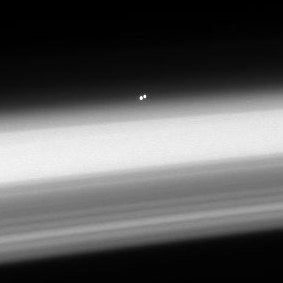The Cassini probe is orbiting Saturn, taking devastatingly beautiful pictures all the time. But sometimes one comes along, and while at first glance it looks like just another routine shot, when you look more closely you realizing you’re gazing into awesomeness.
This picture [click to enjovianate] looks like just another shot of the edge of the planet, doesn’t it? You can see the layering of the atmosphere, which is cool, but it’s otherwise unremarkable. But wait! What’s that weird double blip above the horizon?
That’s Alpha Centauri, the nearest star system to the Sun!
How freaking cool is that? Cassini was about 530,000 km (330,000 miles) from Saturn when it took this shot, but those two stars were 80 million times farther away!
 That picture is no accident. One thing scientists like to do is watch bright stars go behind the planet Saturn itself. As the planet’s atmosphere dims and eventually blocks the star’s light, astronomers can determine all sorts of things about Saturn’s air: its composition, distribution and density with height, and much more… so they tracked the famous duo as they passed behind the planet itself.
That picture is no accident. One thing scientists like to do is watch bright stars go behind the planet Saturn itself. As the planet’s atmosphere dims and eventually blocks the star’s light, astronomers can determine all sorts of things about Saturn’s air: its composition, distribution and density with height, and much more… so they tracked the famous duo as they passed behind the planet itself.
I had the privilege of seeing Alpha Centauri two years ago this month, on my trip to the Galapagos. It was an amazing experience. I had read about that star system all my life, but to actually see it, to have photons that traveled all that distance fall into my eyes, be interpreted by my brain directly… well. It was very touching, and to me, very poetic.
I feel the same way to see this image, too, even though those photons weren’t seen by me directly. But they were detected by our robotic proxy orbiting the solar system’s most beautiful planet a billion kilometers away. And that may seem like a distance most terrible and remote, but it’s practically a warm hug compared to the emptiness that lies between us and this nearest, yet still so forbiddingly distant, star system.
Tip o’ the Zefram Cochrane to Gavin O’Brien. Image credit: NASA/JPL/Space Science Institute